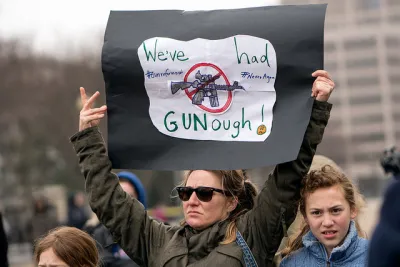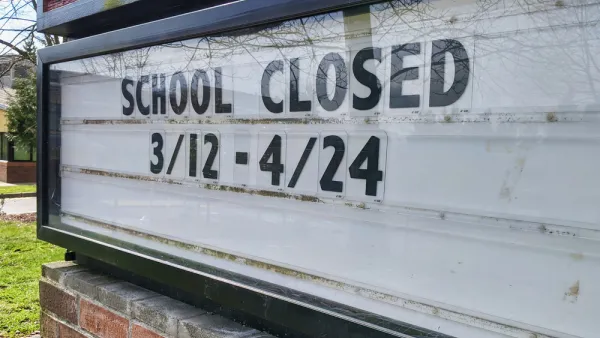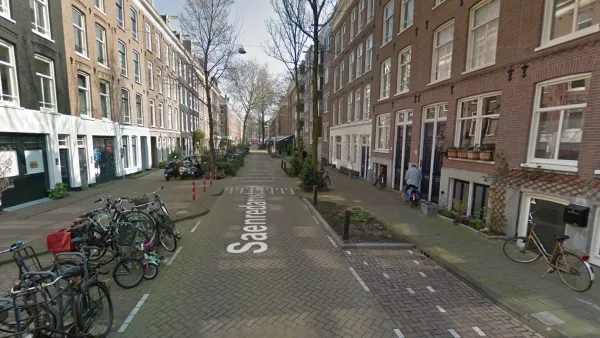In the aftermath of the Marjory Stoneman Douglas High School mass shooting in Florida, the debate has been wide-ranging, from gun safety to arming teachers. All agree students must be safe, so why not look at architecture? The NRA has some tips.

'[I]f the National Rifle Association (NRA) had their way, what would the school of the future look like?" asks Jonathan Hilburg of The Architects Newspaper on Feb 27. "Judging from the design guidelines that came out of their 2013 National School Shield Task Force report (pdf), they’d likely resemble prisons."
The report was commissioned by the NRA after the Sandy Hook Elementary School mass shooting in December 2012, in Newtown, Conn., resulting in the deaths of 20 children between six and seven years old, and six adult staff members. The Parkland shooting resulted in the deaths of 14 students, aged 14-18, and three staff members. Hilburg reviews the report's findings.
[T]he task force’s findings at times come closer to recommendations for bunkers. Ironically, Sandy Hook School reopened in 2016 with a focus on “passive security” and the healing serenity of nature, presenting a diametrically different vision of school design.
The school campus should be devoid of any vegetation much taller than grass because "[t]rees and shrubs provide 'hiding places for people, weapons, and explosive devices...,'" according to the report.
Ideally, schools would retrofit their windows with bulletproof glass and retain the ability to surveil the surrounding area, but with ballistic glass costing around $100 per square foot, it seems more likely that they’d just do away with them altogether.
That observation, about the expense of the security recommendations, was emphasized by Hilburg considering all the other financial needs school districts must consider. For example, "[p]ublic schools across West Virginia remained empty for a fourth school day Tuesday as 20,000 teachers and almost 10,000 support staff pressed their demand for higher pay and relief from onerous health care costs," reports John Bacon for USA TODAY.
It remains to be seen if President Trump's call to "harden our schools" goes beyond arming teachers. The NRA report recommended that federal grants be awarded to schools to help pay for the security improvements.
The report was prescient, though, in terms of parking, when considering some recent acts of terrorism.
While it might be convenient for students and teachers to park near the school, the NRA notes “vehicles can provide potential attackers with a means of concealing and transporting weapons, can be used as a tool in overpowering physical security infrastructure, and can even serve as weapons in and of themselves.”
A Planetizen post did evaluate actual school security recommendations from architects after the Sandy Hook shooting. One prominent finding, though, is that what may work for security may not be conducive to learning.
---------------------------------------------------------------------------------------------------------------
Finally, Planetizen readers might be interested in knowing that the Parkland high school was named for a prominent Miami Herald journalist turned conservationist, Marjory Stoneman Douglas (April 7, 1890 – May 14, 1998). Yes, she died at 108. Per Wikipedia:
Her most influential work was the book The Everglades: River of Grass (1947), which redefined the popular conception of the Everglades as a treasured river instead of a worthless swamp. Its impact has been compared to that of Rachel Carson's influential book Silent Spring (1962). Her books, stories, and journalism career brought her influence in Miami, enabling her to advance her causes.
FULL STORY: The NRA wants to “harden” schools into windowless bunkers

Analysis: Cybertruck Fatality Rate Far Exceeds That of Ford Pinto
The Tesla Cybertruck was recalled seven times last year.

National Parks Layoffs Will Cause Communities to Lose Billions
Thousands of essential park workers were laid off this week, just before the busy spring break season.

Retro-silient?: America’s First “Eco-burb,” The Woodlands Turns 50
A master-planned community north of Houston offers lessons on green infrastructure and resilient design, but falls short of its founder’s lofty affordability and walkability goals.

Test News Post 1
This is a summary

Analysis: Cybertruck Fatality Rate Far Exceeds That of Ford Pinto
The Tesla Cybertruck was recalled seven times last year.

Test News Headline 46
Test for the image on the front page.
Urban Design for Planners 1: Software Tools
This six-course series explores essential urban design concepts using open source software and equips planners with the tools they need to participate fully in the urban design process.
Planning for Universal Design
Learn the tools for implementing Universal Design in planning regulations.
EMC Planning Group, Inc.
Planetizen
Planetizen
Mpact (formerly Rail~Volution)
Great Falls Development Authority, Inc.
HUDs Office of Policy Development and Research
NYU Wagner Graduate School of Public Service



























